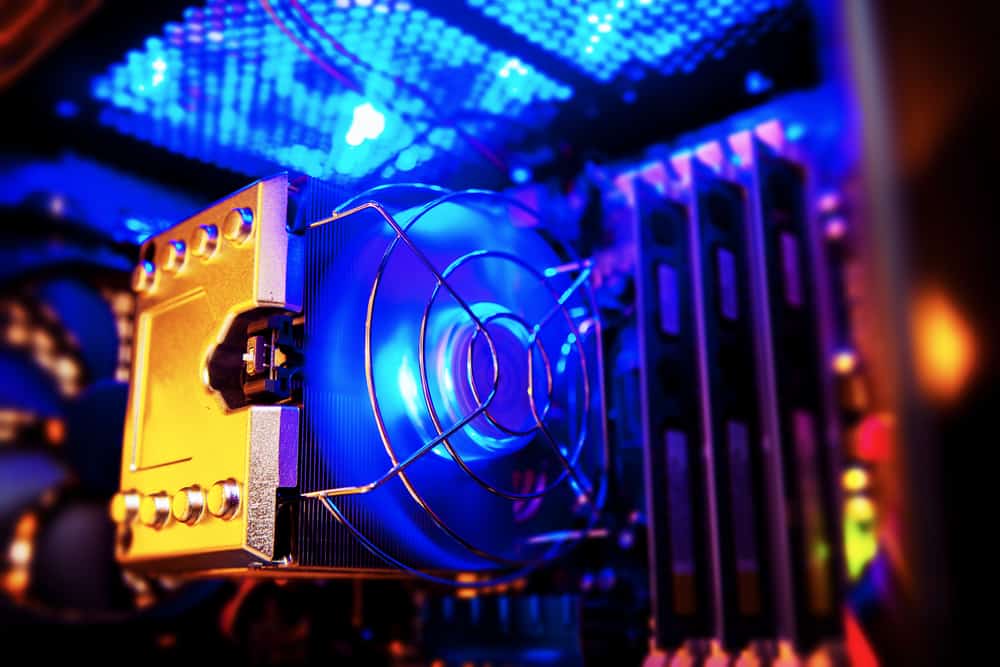How to Change CPU Fan Speed Without BIOS?
You can’t change CPU fan speed without accessing the BIOS settings. However, there are alternative methods available to control and adjust the fan speed on your computer.
When it comes to computer hardware, it is essential to ensure that all components are running at an optimal temperature to prevent any potential damage or overheating issues.
The CPU fan plays a crucial role in maintaining a suitable temperature for the processor.
While adjusting the fan speed is typically done through the BIOS settings, there are situations where accessing the BIOS is not possible.
In such cases, there are alternative methods and software tools available that can help you control and adjust the fan speed on your computer without accessing the BIOS.
We will explore some of these methods and tools that can help you change the CPU fan speed without BIOS.
Reasons To Adjust CPU Fan Speed Without Bios
Adjusting CPU fan speed without accessing the BIOS is possible and comes with its advantages.
By using software tools like SpeedFan or Argus Monitor, you can easily control the fan speed, ensuring better cooling efficiency, reduced noise levels, and improved system performance.
Overheating issues:
- Excessive heat can significantly impact your computer’s performance and potentially damage its components. By adjusting the CPU fan speed without accessing the BIOS, you can prevent overheating and ensure your system runs smoothly.
- Adjusting the fan speed allows for improved airflow, which helps dissipate heat more effectively and maintains optimal operating temperatures for your CPU.
- By avoiding overheating, you can prevent system crashes, freezes, and unexpected shutdowns that can result in data loss and interrupted work.
Noise reduction:
- The CPU fan’s noise can be bothersome, especially if you frequently use your computer for extended periods. Adjusting the fan speed without BIOS access can help reduce the noise generated by the CPU fan while still ensuring adequate cooling.
- Slowing down the fan speed slightly can quieten the system, making it more comfortable to use in quieter environments, such as offices or bedrooms.
- Quieter operation also enhances your concentration, allowing you to focus better on your tasks without the distraction of constant fan noise.
By adjusting your CPU fan speed without BIOS, you can effectively address overheating issues and minimize excessive noise.
Taking control of your computer’s cooling ensures optimal performance while providing a more peaceful computing experience.
However, it’s crucial to remember that any adjustments you make should be based on the specific needs of your system and the workload it handles.
Software Solutions For Changing CPU Fan Speed
Change the CPU fan speed without accessing BIOS using software solutions that help optimize cooling performance.
Easily control and adjust fan speed for better system performance and temperature management.
Controlling the fan speed of your CPU is essential for ensuring optimal cooling and system performance.
While changing the fan speed through BIOS settings is the most common method, not all systems offer this option.
Fortunately, there are software solutions available that allow you to adjust the CPU fan speed without accessing the BIOS.
Here, we will discuss how to download and install fan control software, as well as choosing the right software for your system.
Downloading And Installing Fan Control Software
To change the CPU fan speed without relying on BIOS settings, you can utilize dedicated software designed specifically for fan control. Follow these steps to download and install the software:
- Research: Begin by researching the various fan control software available for your operating system. Consider factors such as compatibility, user reviews, and features offered.
- Select software: Choose the fan control software that best fits your requirements and preferences. Ensure that it supports your operating system and is compatible with your CPU.
- Download the software: Visit the official website of the software and navigate to its download section. Click on the appropriate download link to initiate the downloading process.
- Install the software: Once the download is complete, locate the downloaded file and run the installation wizard. Follow the on-screen instructions to install the software on your system.
- Launch the software: After successful installation, locate the software in your system’s applications or programs folder. Open the software to access its interface and begin controlling the fan speed of your CPU.
Choosing The Right Software For Your System
With numerous fan control software options available, it’s crucial to select the one that suits your system. Consider the following aspects when choosing the right software:
- Compatibility: Ensure that the software is compatible with your operating system, as well as the specific model of your CPU.
- User-friendly interface: Opt for software that offers a user-friendly interface, allowing you to easily navigate and control the fan speed.
- Customizability: Look for software that provides customization options, such as the ability to set fan speed profiles based on specific CPU temperatures or system loads.
- Stability and reliability: Choose software that has a good reputation for stability and reliability, as these factors play a vital role in ensuring smooth operations and preventing system instability.
- Support and updates: Consider software that receives regular updates and offers technical support if needed, as this indicates the developer’s commitment to improving the software over time.
Remember to thoroughly research and read user reviews before making your final choice.
Once you have selected and installed the appropriate fan control software, you can enjoy the flexibility of adjusting your CPU fan speed without BIOS access.
Adjusting CPU Fan Speed With Fan Control Software
Adjusting CPU fan speed without accessing the BIOS is possible with fan control software.
This software allows you to change the fan speed settings easily, optimizing cooling performance based on your needs.
Understanding The Interface Of The Software
The fan control software offers a user-friendly interface that allows you to easily adjust the CPU fan speed without accessing the BIOS settings.
Here’s an overview of how to navigate and understand the interface:
- Upon launching the software, you will be greeted with a clean and intuitive interface.
- The main window typically displays real-time information such as the current fan speed, temperature, and system usage.
- Various tabs or sections allow you to access different settings related to fan control.
- Look for options that specifically mention fan speed control or fan curve settings.
- Familiarize yourself with the available sliders or numerical fields that allow you to adjust the CPU fan speed.
Customizing Fan Settings For Optimal Performance
Customizing the fan settings can help optimize your CPU cooling and strike a balance between noise levels and cooling efficiency.
Here are some key options you may encounter when customizing fan settings:
- Fan speed control: Adjust the fan speed by selecting a percentage or RPM value. Increasing the speed improves cooling performance but may result in more noise.
- Fan curve customization: Customize a fan curve to regulate the fan speed based on temperature thresholds. This allows for a more precise and dynamic control of fan speed according to system demands.
- Temperature sensors: Some software provides options to choose which temperature sensors to base the fan speed on. This ensures that fan speed is adjusted according to the most relevant temperature readings.
- Presets or profiles: You may have the option to create and save different fan profiles for various scenarios, such as gaming, video editing, or idle usage. This lets you quickly switch between profiles based on your needs.
Saving And Applying The Changes
After customizing the fan settings as per your preferences, it’s crucial to save and apply the changes.
Here’s what you need to do:
- Look for a “Save” or “Apply” button within the software interface.
- Click on the appropriate button to save your customized settings.
- Some software may require you to confirm the changes before they take effect.
- Once the changes are saved, the software will automatically adjust the CPU fan speed according to the modified settings.
- Monitor the fan speed and system temperature to ensure that the changes are functioning as expected. Make further adjustments if necessary.
Remember to refer to the software’s documentation or online resources for specific instructions related to the particular fan control software you are using.
So, grab hold of the software, explore its user-friendly interface, customize the fan settings for optimal performance, and save those changes to enjoy an efficiently cooled CPU!
Alternative Methods To Manage Cpu Fan Speed
Looking for alternative methods to manage CPU fan speed without accessing the BIOS system?
Discover effective techniques to change CPU fan speed using software solutions and third-party applications.
Maintain optimal performance and prevent overheating with these simple yet efficient strategies.
Controlling the speed of your CPU fan is crucial for maintaining optimal performance and ensuring your system stays cool.
While changing fan speed through the BIOS is the most common method, there are alternative ways to achieve this without accessing the BIOS settings.
In this section, we will explore two effective methods: using hardware solutions like fan controllers and implementing proper cable management for better cooling.
Using Hardware Solutions Like Fan Controllers
Fan controllers are handy devices that allow you to manually adjust the speed of your CPU fan.
They give you precise control over the fan’s RPM (rotations per minute), enabling you to strike the perfect balance between performance and cooling.
Here are some advantages of using fan controllers:
- Easy installation: Fan controllers can be easily installed in your computer case, providing hassle-free access to control fan speed.
- Customizable settings: With a fan controller, you have the flexibility to customize fan speed based on your specific needs. You can increase the fan speed during intensive tasks, such as gaming or video editing, and reduce it during lighter usage.
- Improved noise management: Fan controllers help you achieve a quieter system by reducing the fan speed when cooling demands are lower.
- Temperature monitoring: Some advanced fan controllers come with temperature sensors that allow you to monitor the CPU and system temperatures in real time.
Cleaning The CPU and Fan To Improve Airflow
A common issue that can impact the performance of your CPU fan is dust accumulation, which restricts airflow and increases the temperature inside your case.
Regularly cleaning your CPU and fan can help alleviate this problem. Here are some key benefits of keeping your CPU and fan clean:
- Enhanced cooling efficiency: By removing dust buildup, you can improve the airflow around the CPU and fan, ensuring they operate at optimal temperatures.
- Prolonged fan lifespan: Dust can cause the fan to work harder, leading to increased wear and tear. Cleaning the fan regularly will extend its lifespan and prevent premature failure.
- Reduced noise levels: Dust buildup can create additional noise as the fan struggles to maintain proper cooling. Cleaning the CPU and fan can help reduce unwanted noise, creating a more peaceful environment.
Proper Cable Management For Better Cooling
Cable management plays a vital role in optimizing airflow within your computer case.
Tangled or obstructive cables can disrupt the natural airflow path and impede proper cooling.
Proper cable management offers several benefits:
- Improved airflow: Organizing your cables allows for smooth airflow, preventing hot air from getting trapped and replacing it with cooler air.
- Reduced heat buildup: When cables are tightly packed or mangled, they can act as an insulator, trapping heat around the CPU and other components. Effective cable management reduces heat buildup, enhancing overall cooling performance.
- Easier maintenance: Neatly arranged cables make it easier to access and clean components, ensuring regular maintenance is hassle-free.
- Aesthetically pleasing: Along with the practical advantages, proper cable management provides a clean and visually appealing interior, giving your computer setup a professional look.
By utilizing hardware solutions like fan controllers, keeping your CPU and fan clean, and implementing proper cable management techniques, you can effectively manage CPU fan speed without accessing the BIOS settings.
Incorporating these alternative methods will enhance cooling performance, promote longevity, and ultimately optimize your computing experience.
Precautions And Best Practices
Learn how to change the CPU fan speed without accessing the BIOS by following these precautions and best practices.
Discover effective methods to adjust the fan speed and optimize your system’s cooling performance.
Monitoring temperature and fan speed using monitoring tools:
- It is essential to monitor the temperature and fan speed of your CPU to ensure optimal performance and prevent overheating. By using monitoring tools, you can keep track of these crucial metrics. Some popular options include:
- SpeedFan: This software allows you to monitor CPU temperature, fan speed, and voltages. It provides real-time data and can send notifications if the temperature exceeds safe levels.
- Core Temp: With a simple interface, Core Temp displays the temperature of each CPU core. It also provides information on maximum temperature, allowing you to configure fan speed accordingly.
- HWMonitor: This tool offers comprehensive monitoring of various hardware components, including CPU temperature and fan speed. It provides accurate readings and can help you gain insights into your system’s performance.
Being cautious while adjusting fan speed to avoid overheating or damage:
- While it might be tempting to tweak your CPU fan speed settings for better cooling or reduced noise, it is crucial to exercise caution. Adjusting the fan speed improperly can lead to overheating or even damaging your CPU. Keep the following precautions in mind:
- Gradual adjustments: When changing the fan speed, make small and incremental adjustments rather than drastic ones. This approach allows you to monitor the impact and avoid sudden temperature spikes.
- Monitor temperature: Continuously monitor the CPU temperature while adjusting the fan speed to ensure it remains within safe limits. Overclocking or pushing the system beyond its capabilities could result in overheating.
- Test stability: After adjusting the fan speed, test the stability of your system by running resource-intensive tasks or stress tests. This step ensures that the changes made are suitable for your system and do not introduce instability.
Regularly maintaining and cleaning the CPU and fan:
- To optimize your CPU fan speed, regular maintenance and cleaning are necessary. Dust and debris can accumulate on the CPU heatsink and fan over time, impacting its effectiveness. Follow these practices to keep your system running efficiently:
- Scheduled cleaning: Set a regular cleaning schedule to prevent dust buildup. Remove the CPU fan and carefully clean it using compressed air or a soft brush. Ensure that the system is powered off during this process.
- Check for obstructions: Inspect the fan for any obstructions that might hinder airflow. Remove any cables or objects that might block the fan blades, enhancing its cooling efficiency.
- Replace if necessary: If the CPU fan is damaged or not functioning correctly, consider replacing it with a suitable and compatible replacement. A faulty fan can lead to inadequate cooling and potential damage to your CPU.

Credit: www.crisisshelter.org
Final Thoughts On Changing CPU Fan Speed Without Bios
Changing CPU fan speed without BIOS is possible by using third-party software or utilities that allow manual control over fan speeds.
These tools provide an alternative solution for adjusting fan speeds without accessing BIOS settings, ensuring optimal cooling performance for your CPU.
The Benefits Of Adjusting Fan Speed For Performance And Noise Reduction
Adjusting the CPU fan speed can have a significant impact on both performance and noise reduction.
By optimizing the fan speed, you can ensure that your system runs smoothly without overheating while also minimizing unnecessary noise.
Here are some key benefits of adjusting the fan speed:
- Improved Performance: When your CPU runs at an optimal temperature, it can perform at its best. By adjusting the fan speed, you can prevent your CPU from overheating and causing performance issues. This is especially important when running intensive tasks or gaming, as high temperatures can lead to thermal throttling and reduce performance.
- Noise Reduction: Many CPUs come with default fan settings that prioritize cooling over noise reduction. However, this can result in noisy operations. By adjusting the fan speed, you can strike a balance between keeping the CPU cool and reducing unnecessary noise. This is particularly beneficial if you are working in a quiet environment or if you find the fan noise distracting.
- Energy Efficiency: Higher fan speeds require more power, which can impact energy efficiency. By adjusting the fan speed to an optimal level, you can save energy and reduce power consumption. This is especially relevant for users concerned about energy usage or running their systems on battery power.
Exploring Different Options Based On Your System Requirements
Depending on your system requirements, there are several options available for changing CPU fan speed without BIOS.
Here are a few methods to consider:
- Software-Based Fan Control: Many motherboard manufacturers provide software utilities that allow you to control the fan speed directly from the operating system. These utilities often offer intuitive interfaces where you can adjust fan curves, set specific speeds, or create profiles based on temperature thresholds.
- Third-Party Fan Control Programs: You can also explore third-party software tools that offer more advanced fan control options. These programs can provide additional features such as real-time temperature monitoring, custom fan profiles, and automatic fan speed adjustment based on system load or CPU temperature.
- Fan Speed Controller Hardware: If you prefer a physical solution, you can consider purchasing a fan speed controller. These devices allow you to manually adjust fan speeds using knobs or buttons. They are typically connected to the motherboard via the fan headers and provide independent control for multiple fans.
- Fan Resistor or Adapters: Another option is to use fan resistors or adapters to reduce fan speed. These devices limit the amount of power supplied to the fan, effectively reducing its speed. However, it’s important to note that this method may not offer as precise control as software-based solutions.
Remember, before making any changes to your CPU fan speed, ensure you are aware of your system’s temperature limits and use caution while experimenting with different settings.
FAQs of How to Change CPU Fan Speed without Bios
How Do I Change My Fan Speed Without Bios?
To change your fan speed without BIOS, utilize third-party software designed for fan control.
How Do I Manually Control My CPU Fan Speed?
To manually control your CPU fan speed, access your motherboard’s BIOS settings and look for the fan control option. Adjust it to your desired speed.
How Do I Change My CPU Fan Speed Windows 10?
To change your CPU fan speed in Windows 10, follow these steps: 1. Open the BIOS settings on your computer. 2. Navigate to the “Hardware Monitor” or “Fan Control” section. 3. Adjust the fan speed settings to your desired level. 4. Save the changes and exit the BIOS settings. Keep in mind that not all BIOS settings have fan speed control options.
Is 3000 Rpm Too High Cpu?
A CPU running at 3000 rpm is not too high.
Conclusion
Changing the CPU fan speed without accessing the BIOS is possible using alternative methods.
By utilizing software applications like SpeedFan or Argus Monitor, users can easily adjust the fan speed to maintain optimal temperature levels while avoiding manual intervention.
These software options offer user-friendly interfaces, enabling even those with limited technical expertise to make necessary adjustments.
Additionally, external fan controllers are available for those who prefer a hardware-based solution.
Whichever method you choose, it’s important to ensure that the fan speed is appropriate for your specific system and workload.
Remember to monitor the temperatures and make adjustments as needed to prevent any overheating issues.
Overall, being able to control the CPU fan speed without relying solely on the BIOS provides users with flexibility and convenience in maintaining a cool and efficient computer system.





